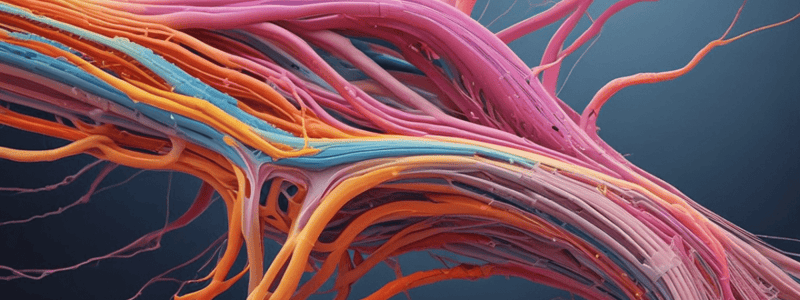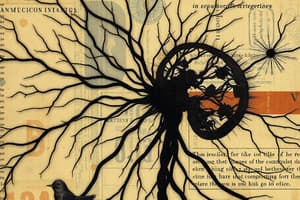Podcast
Questions and Answers
What is the term for the ability to generate spontaneous potentials in cardiac muscle?
What is the term for the ability to generate spontaneous potentials in cardiac muscle?
- Rate of Recruitment
- Neuromuscular junction
- Autorhythmia (correct)
- Desmosome connection
Which type of muscle fiber activation spreads through gap junctions for a quick response?
Which type of muscle fiber activation spreads through gap junctions for a quick response?
- Fast glycolytic fibers
- Visceral smooth muscle (correct)
- Endomysium present fibers
- Multi-unit smooth muscle
In the sliding filament model, which type of muscle fiber activation is dependent on the recruitment of motor units?
In the sliding filament model, which type of muscle fiber activation is dependent on the recruitment of motor units?
- Cardiac muscle fibers
- Slow oxidative fibers
- Fast glycolytic fibers (correct)
- Multi-unit smooth muscle
What leads to hypertrophy in muscles as a result of weight training?
What leads to hypertrophy in muscles as a result of weight training?
What is the main cause of fatigue according to the text?
What is the main cause of fatigue according to the text?
Which type of muscle fiber has few gap junctions, causing only a specific fiber to fire upon stimulation?
Which type of muscle fiber has few gap junctions, causing only a specific fiber to fire upon stimulation?
What is the first step in the mechanism of skeletal muscle contraction?
What is the first step in the mechanism of skeletal muscle contraction?
When Ca2+ attaches to troponin in the sliding filament model, what does troponin do?
When Ca2+ attaches to troponin in the sliding filament model, what does troponin do?
What happens during the attachment phase in the sliding filament model?
What happens during the attachment phase in the sliding filament model?
What is the role of acetylcholinesterase (AChE) in muscle contraction?
What is the role of acetylcholinesterase (AChE) in muscle contraction?
Which component of the neuromuscular junction contains neurotransmitter?
Which component of the neuromuscular junction contains neurotransmitter?
What happens after myosin uses ADP as energy in the power stroke during muscle contraction?
What happens after myosin uses ADP as energy in the power stroke during muscle contraction?
What is the function of the sarcoplasmic reticulum in a muscle fiber?
What is the function of the sarcoplasmic reticulum in a muscle fiber?
Which connective tissue layer surrounds each individual muscle and separates them from each other?
Which connective tissue layer surrounds each individual muscle and separates them from each other?
What is the function of T-tubules in muscle fibers?
What is the function of T-tubules in muscle fibers?
Which organelle in a muscle fiber is responsible for providing ATP for muscle contraction?
Which organelle in a muscle fiber is responsible for providing ATP for muscle contraction?
What is the function of myoglobin in muscle fibers?
What is the function of myoglobin in muscle fibers?
What part of the muscle fiber serves as the contractile unit?
What part of the muscle fiber serves as the contractile unit?
What is the main function of the slow-twitch (Type I) muscle fibers?
What is the main function of the slow-twitch (Type I) muscle fibers?
What is the primary difference between fast-twitch (Type IIb) and fast-oxidative (Type IIa) muscle fibers?
What is the primary difference between fast-twitch (Type IIb) and fast-oxidative (Type IIa) muscle fibers?
According to the sliding filament model, what happens during the contraction of a muscle fiber?
According to the sliding filament model, what happens during the contraction of a muscle fiber?
What is the main role of creatine phosphate (stored in muscle) in the energy systems described in the text?
What is the main role of creatine phosphate (stored in muscle) in the energy systems described in the text?
What is the relationship between the size of muscle fibers and their contractile properties?
What is the relationship between the size of muscle fibers and their contractile properties?
What is the main function of the sarcoplasmic reticulum in muscle contraction?
What is the main function of the sarcoplasmic reticulum in muscle contraction?
Which of the following statements about myosin is correct?
Which of the following statements about myosin is correct?
What is the function of tropomyosin in the thin filaments?
What is the function of tropomyosin in the thin filaments?
Which of the following statements about the organization of thick and thin filaments is correct?
Which of the following statements about the organization of thick and thin filaments is correct?
What is the function of titin in the sarcomere?
What is the function of titin in the sarcomere?
What is the significance of the 'all or none' response in motor units?
What is the significance of the 'all or none' response in motor units?
How is the graded response of muscle contraction achieved?
How is the graded response of muscle contraction achieved?
Flashcards are hidden until you start studying
Study Notes
Muscle Physiology
- We are 1.3-1.5 times stronger eccentrically than concentrically
- Eccentric contractions rip myosin from actin, leading to muscle soreness and repair, which increases strength
- The force of contraction is less than the force of the load during eccentric contractions
Muscle Tension
- The amount of muscle tension is dependent on two factors:
- Recruitment: the number of motor units (MUs) activated
- Rate of recruitment (coding frequency): how rapidly the nervous system stimulates the muscle
Muscle Fiber Types
- Slow-twitch (Type I, SO): aerobic pathways, dark in color, small motor units, slower, high endurance, high myoglobin, and dense capillary beds
- Fast-oxidative (Type IIa, FOG): intermediate between Type I and Type IIb, similar to fast-twitch but with more mitochondria
- Fast-twitch (Type IIb/x, FG): anaerobic pathways, light in color, large motor units, fast, fewer mitochondria, and little/no myoglobin
Muscle Fiber Distribution
- Skeletal muscles typically have a mix of all three fiber types, but the proportion varies from muscle to muscle
- Single motor units have single types of fibers
- Postural muscles tend to have slow-twitch fibers (e.g., soleus)
- Eye and hand muscles tend to have fast-twitch fibers only
Muscle Contractions
- Isotonic contractions:
- Concentric: muscle contracts as it shortens (force of contraction > force of load)
- Eccentric: muscle contracts as it lengthens (force of load > force of contraction)
Muscle Function and Aging
- Between ages 30-50, there is a 10% loss of muscle mass
- By age 80, there is a 40% loss of muscle mass
Muscle Structure
- Thick filaments:
- Made up of myosin, with a binding site for actin and ATP
- Elongated tail with a golf club head
- Thin filaments:
- Made up of actin, tropomyosin, and troponin
- Double-stranded helix with binding sites for myosin
- Sarcomere structure:
- A-bands: isotropic, area of thick filaments
- I-bands: area of no overlap between thin filaments
- H-zone: area of non-overlap between thick filaments
- M-line: proteins in the middle of the sarcomere, anchoring myosin tails
- Z-disc: proteins separating sarcomeres, anchoring thin filaments
Motor Units and Neuromuscular Junction
- Motor unit: motor neuron and all the muscle fibers it innervates
- Motor neuron can stimulate a few to 2,000 muscle fibers
- All or none response: all muscle fibers of a motor unit contract at the same time
- Recruitment: smallest motor units are recruited first, and as demand increases, larger motor units are recruited
- Fatigue sets in when motor units can no longer be recruited
Neuromuscular Junction
- Contact site of motor neuron on muscle fiber
- Components:
- Synaptic knob: end of axon, secretes neurotransmitter
- Synaptic vesicles: contain neurotransmitter
- Synaptic cleft: space between synaptic knob and post-synaptic membrane
- Motor end plate: post-synaptic membrane on muscle fiber
- Acetylcholine receptors: on motor end plate, receives neurotransmitter
- Acetylcholinesterase: breaks down neurotransmitter
Studying That Suits You
Use AI to generate personalized quizzes and flashcards to suit your learning preferences.




